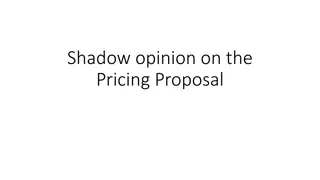Study on Pricing and Place Strategy of Himalayan Java Coffee: A Detailed Analysis
This report delves into the pricing and place strategies of Himalayan Java coffee, focusing on factors influencing coffee pricing and selection of outlet locations. The study aims to identify the target market, understand competitive dynamics, and analyze factors impacting coffee sales at Himalayan Java outlets. Research methods include a descriptive approach using primary and secondary data sources, with data analysis tools like descriptive statistics. The report also examines various pricing strategies employed by Himalayan Java to drive revenue and profitability.
Download Presentation

Please find below an Image/Link to download the presentation.
The content on the website is provided AS IS for your information and personal use only. It may not be sold, licensed, or shared on other websites without obtaining consent from the author. Download presentation by click this link. If you encounter any issues during the download, it is possible that the publisher has removed the file from their server.
E N D
Presentation Transcript
Proposal of Summer Project Report on Pricing and Place strategy of Himalayan Java Presenters Samipa Dahal Pushpa Maharjan Shrijana Shrestha Sharad Sharma Niyam Raj Shrestha Tulshiram Ghemosu Ramsingh Budal Netra Bahadur Swar Presented at: Janapriya Multiple Campus Pokhara 8 Jan 2017
Context of Information Many believe that consumer prices are high relative to green coffee-bean prices, Lower consumer prices would increase demand for coffee beans. Coffee demand is estimated on data for the period 1968-2002. Segmentation of coffee market affects the sales revenue.
Purpose The main purpose of the study is to assess the pricing and place strategy of Himalayan Java. Specific purposes : To evaluate the determining factors of coffee pricing of Himalayan Java. To examine the factors affecting in selection of Himalayan Java Outlet.
Significance of the Study Identification of target coffee market of Himalayan Java. Understanding the nature of coffee market competition of Himalayan Java. Factors affecting sale of coffee in Himalayan Java Outlet.
Literature Survey Author /Date Finding International Coffee Council (2014) The study focused on coffee market development, in terms of fundamentals and prices. Also focused of current challenges and opportunities for the coffee market . Dick Durevall (2007) The study focused that the permanent decrease in consumer prices would only increase exports of coffee beans to Sweden for a couple of years.
Research Methods Used Descriptive Research Method Sources of Data Primary ( Questionnaire survey) Secondary (Annual reports, Publications) Sample Selection Based on brand image (pioneer in coffee market)
Research Methods Used Data Analysis Tools Descriptive Statistics Revenue and Profitability of Himalayan Java Questionnaire Survey ( Interview with sales managers) Premium pricing Price bundling Complementary pricing Penetration pricing Cost plus pricing Coupon/discount pricing Periodic discounting Demand oriented pricing Competition oriented pricing
Research Methods Used Questionnaire Survey ( Interview with sales managers) Potential customers analysis Student and faculty Teenagers Office workers Business persons Artists Writers Foreigners
References: World coffee trade (2013). A review of the markets, challenges and opportunities. London: International Coffee Council. Durevall, D. (2007). Demand for Coffee: The Role of Prices, Preferences and Market Power. Gothenburg: University of Gothenburg Retrieved from: Dick Durevallhttps://www.researchgate.net/publication/5 094816_Demand_for_Coffee_The_Role_of_Prices_Pr eferences_and_Market_Power Devkota, R. (2009). Himalayan Java Marketing Case. Lalitpur, (An unpublished case study of KUSOM).























